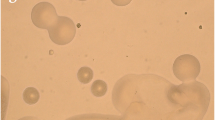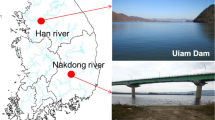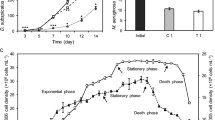Abstract
The viable but nonculturable (VBNC) state has been found to be a growth strategy used by many aquatic pathogens; however, few studies have focused on VBNC state on other aquatic bacterial groups. The purpose of this study was to explore the VBNC state of cyanobacteria-lysing bacteria and the conditions that regulate their VBNC state transformation. Three cyanobacteria-lysing heterotrophic bacterial strains (F1, F2 and F3) were isolated with liquid infection method from a lake that has experienced a cyanobacterial bloom. According to their morphological, physiological and biochemical characteristics and results of 16SrDNA sequence analysis, F1, F2 and F3 were identified as strains of Staphylococcus sp., Stappia sp. and Microbacterium sp., respectively. After being co-cultured with the axenic cyanobacterium, Microcystis aeruginosa 905, for 7 days, strains F1, F2 and F3 exhibited an inhibition effect on cyanobacterial growth, which was expressed as a reduction in chlorophyll concentration of 96.0%, 94.9% and 84.8%, respectively. Both autoclaved and filtered bacterial cultures still showed lytic effects on cyanobacterial cells while centrifuged pellets were less efficient than other fractions. This indicated that lytic factors were extracelluar and heat-resistant. The environmental conditions that could induce the VBNC state of strain F1 were also studied. Under low temperature (4°C), distilled deionized water (DDW) induced almost 100% of F1 cells to the VBNC state after 6 days while different salinities (1%, 3% and 5% of NaCl solution) and lake water required 18 days. A solution of the cyanobacterial toxin microcystin-LR (MC-LR) crude extract also induced F1 to the VBNC state, and the effect was stronger than DDW. Even the lowest MC-LR concentration (10 μg L−1) could induce 69.7% of F1 cells into VBNC state after 24 h. On the other hand, addition of Microcystis aeruginosa cells caused resuscitation of VBNC state F1 cells within 1 day, expressed as an increase of viable cell number and a decrease of VBNC ratio. Both VBNC state and culturable state F1 cells showed lytic effects on cyanobacteria, with their VBNC ratio varying during co-culturing with cyanobacteria. The findings indicated that VBNC state transformation of cyanobacteria-lysing bacteria could be regulated by cyanobacterial cells or their toxin, and the transformation may play an important role in cyanobacterial termination.






Similar content being viewed by others
References
Amel BK-N, Amine B, Amina B (2006) Survival of Vibrio fluvialis in seawater under starvation conditions. Microbiol Res 9:2–6
Arana I, Muela A, Iriberri J (1992) Role of hydrogen peroxide in loss of culturability mediated by visible light in Escherichia coli in a freshwater ecosystem. Appl Environ Microbiol 58:3903–3907
Ashton M, Rosado W, Govind NS, Tosteson TR (2003) Culturable and nonculturable bacterial symbionts in the toxic benthic dinoflagellate Ostreopsis lenticularis. Toxicon 42:419–424
Barcina I, Arana I (2009) The viable but nonculturable phenotype: a crossroads in the life-cycle of non-differentiating bacteria? Rev. Environ Sci Biotechnol 8:245–255
Berg KA, Lyra C, Sivonen K, Paulin L, Suomalainen S, Tuomi P, Rapala J (2009) High diversity of cultivable heterotrophic bacteria in association with cyanobacterial water blooms. ISME J 3:314–325
Berland BR, Bonin DJ, Maestrini SY (1972) Are some bacteria toxic for marine algae? Mar Biol 12:189–193
Christopher GP, Tom LD (2006) Infection, growth, and community level consequences of a diatom pathogen in a sonoran desert stream. J Phycol 29:442–452
Cousins IT, Healing DJ, James HA, Sutton A (1996) Biodegradation of microcystin-LR by indigenous mixed bacterial populations. Wat Res 30:481–485
Daft MJ, McCord SB, Stewart WDP (1975) Ecological studies on algae-lysing bacteria in fresh waters. Freshwat Biol 5:557–596
Fraleigh PC (1988) Myxococcal predation on cyanobacterial populations: nutrient effects. Limnol Oceanogr 33:476–483
Gao G, Qin B, Sommaruga R, Psenner R (2007) The bacterioplankton of Lake Taihu, China: abundance, biomass, and production. Hydrobiologia 581:177–188
Gasol JM, Garcés E, Vila M (2005) Strong small-scale temporal bacterial changes associated with the migrations of bloom-forming dinoflagellates. Harmful Algae 4:771–781
Gourmelon M, Cillard J, Pommepuy M (1994) Visible light damage to Escherichia coli in seawater: oxidative stress hypothesis. J Appl Bacteriol 77:105–112
Gumbo RJ, Ross G, Cloete ET (2008) Biological control of Microcystis dominated harmful algal blooms. Afr J Biotechnol 7:4765–4773
Han Q, Hu Z, Lei A, Song L, Liu Y (2005) Studies on the relationship between microcystin-LR and viviform state of a bacterium in natural bodies of water. Acta Hydrobiologia Sinica (in Chinese) 29:199–202
Hayashida A, Tanaka S, Teramoto T, Nanri N, Yoshino S, Furukawa K (1991) Isolation of anti-algal Pseudomonas stutzeri strains and their lethal activity for Chattonella antiaua. Agric Biol Chem 55:787–790
Imai I, Kim M-C, Nagasaki K, Itakura S, Ishida Y (1998) Relationships between dynamics of red tide causing raphidophycean flagellates and algicidal micro-organisms in the coastal sea of Japan. Phycol Res 46:139–146
Imai I, Sunahara T, Nishikawa T, Hori Y, Kondo R, Hiroishi S (2001) Fluctuations of the red tide flagellates Chattonella spp. (Raphidophyceae) and the algicidal bacterium Cytophaga sp. in the Seto Inland Sea, Japan. Mar Biol 138:1043–1049
Islam MS, Drasar BS, Bradley DJ (1990) Long term persistence of toxigenic Vibrio cholerae O1 in the mucilaginous sheath of a blue-green alga, Anabaena variabilis. J Trop Med Hyg 93:133–139
Islam MS, Mahmuda S, Morshed MG, Bakht HBM, Khan MNH, Sack RB, Sack DA (2004) Role of cyanobacteria in the persistence of Vibrio cholerae O139 in saline microcosms. Can J Microbiol 50:127–131
Oliver JD (1993) Formation of viable but nonculturable cells. In: Kjelleberg S (ed) Starvation in bacteria. Plenum, New York, pp 239–272
Oliver JD (2010) Recent findings on the viable but nonculturable state in pathogenic bacteria. FEMS Microbiol Rev 34:415–425
Oliver JD, Nilsson L, Kjelleberg S (1991) Formation of nonculturable Vibrio vulnificus cells and its relationship to the starvation state. Appl Environ Microbiol 57:2640–2644
Pan G, Hu Z, Lei A, Li S (2008) Effect of crude microcystin on the viable but non-culturable state of Aeromonas sobria in aquatic environment. J Lake Sci (in Chinese) 20:105–109
Peng C, Wu G, Xi Y, Xia Y, Zhang T, Zhao Y (2003) Isolation and identification of three algae-lysing bacteria and their lytic effects on blue-green algae (cyanobacteria). Res Environ Sci (In Chinese) 16:37–40
Rashidan KK, Bird DF (2001) Role of predatory bacteria in the termination of a cyanobacterial bloom. Microb Ecol 41:97–105
Servais P, Prats J, Passerat J, Garcia-Armisen T (2009) Abundance of culturable versus viable Escherichia coli in freshwater. Can J Microbiol 55:905–909
Shen P, Fan X, Li G. (Eds) (1999) Microbiology experiment. Beijing High Education. 244 pp
Shen Q, Tang C, Cheng K, Liao M, Zhao Y (2007) Characteristics and isolation of alage-lysing active substance from an algae-lysing bacteria. Environ Sci Tech (In Chinese) 30:1–5
Sivonen K, Jones G (1999) Cyanobacterial toxins. In: Chorus I, Bartram J (eds) Toxic cyanobacteria in water: a guide to public health significance, monitoring and management. E and FN Spon, London, pp 41–111
Acknowledgments
We thank the anonymous reviewers for thoroughly reading the paper, providing thoughtful comments. This work was been supported by the National Natural Science Foundation of China (nos. 31070323 and 30770340), Major Science and Technology Program for Water Pollution Control and Treatment (nos. 2009ZX07423-003 and 2009ZX07101-011-03), Shenzhen Grant Plan for Science and Technology to Z. Hu, International Mobility Fund Grant of Royal Society of New Zealand (IMF10-A61) to W.L.Wihte and Z.Hu, and a China Postdoctoral Science Foundation (no. 20110490924) to H. Chen.
Author information
Authors and Affiliations
Corresponding author
Rights and permissions
About this article
Cite this article
Chen, H., Fu, L., Luo, L. et al. Induction and Resuscitation of the Viable but Nonculturable State in a Cyanobacteria-Lysing Bacterium Isolated from Cyanobacterial Bloom. Microb Ecol 63, 64–73 (2012). https://doi.org/10.1007/s00248-011-9928-2
Received:
Accepted:
Published:
Issue Date:
DOI: https://doi.org/10.1007/s00248-011-9928-2




